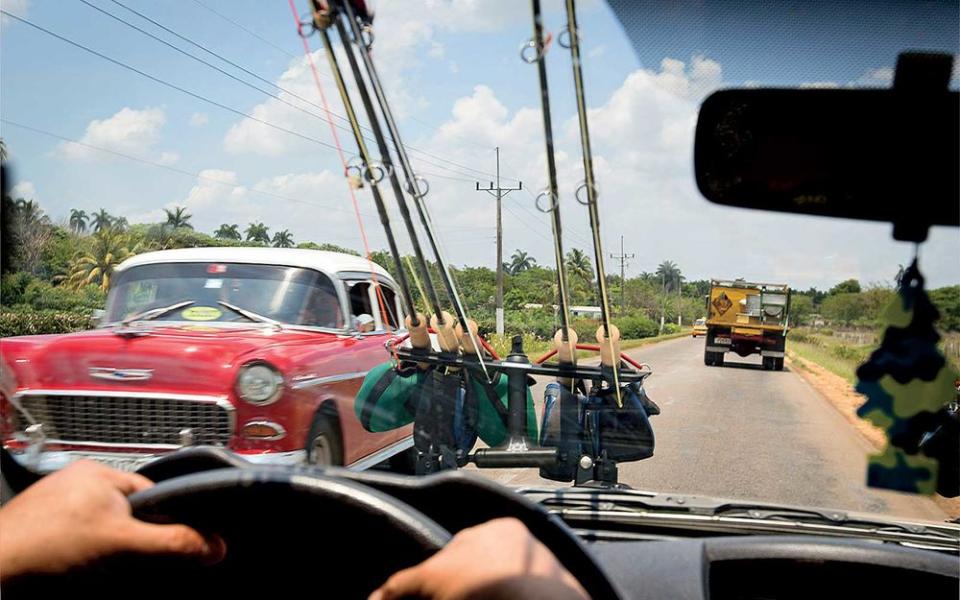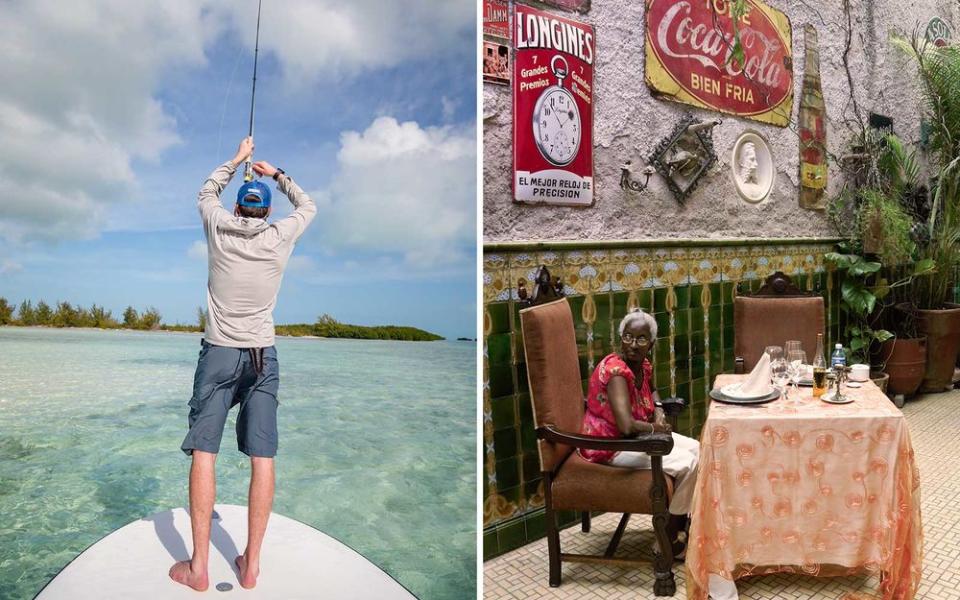The Underrated Outdoor Activity You'll Want to Try On Cuba's Southern Coast
I stood in the bow of our skiff, scanning the water. Behind me, on a platform in the stern, our guide Felipe Rodriguez poled us along, gondolier-style. It was sunny—ideal for visibility—but what the sun gave, the 25 mile-an-hour wind took, obscuring our view of the underwater world. Fly-fishing for bonefish has an aspect of hunting, but it always takes awhile before I can recognize my quarry. Until I could make out the ghostly shadow of a moving bonefish, Felipe would be my eyes. Every now and then, I caught a fleeting glimpse of a few bonefish in the lee of the low-lying mangroves. Ahead, all the way to the horizon, was a windswept expanse of emerald green, aquamarine, and sun-bleached white.
For fly-rod anglers, catching bonefish—silver-scaled creatures that inhabit the sun-drenched tidal flats of the tropics—is supremely challenging and rewarding. You must stalk with stealth: a sudden movement or errant cast will send the fish rocketing for deeper water. I've fished for them off the Yucatán and the Florida Keys, but I've long been entranced by the story of baseball immortal Ted Williams, who caught 40 bonefish one day in Cuba and called it the best fishing of his life. So last fall, when my old friend Tom Rosenbauer, now marketing manager at the Orvis Company, called to tell me about a trip he had put together off Cuba's southern coast with five other anglers, I was in.

Despite recent changes in regulations, U.S. citizens can still travel to Cuba easily, provided they spend a couple of days engaging with Cuban culture and meeting locals. That makes it harder for individuals to plan a trip but doesn't change much for organized tours. Orvis made the arrangements, hooking us up with a great guide, Orlando Ochoa Méndez, a DJ who told us he'd learned English by listening to Eminem. We started with a whirlwind tour of Havana, a part of the trip I thought would feel rote but wound up being a hit. We roamed art galleries and a museum, attended a living-room concert by a folk singer, and marveled at a workshop where jalopies are restored to their shining 1950s glory. We drank mojitos copiously and had a supernal suckling pig at Al Carbon. There was live music everywhere. You couldn't help walking around with a mambo bounce in your step.
Our fishing destination was located across the island, near the Bay of Pigs. A decommissioned army tank marked our turnoff to the Hotel Playa Larga. Not a luxury hotel, but fine for a fish camp: clean rooms, functioning air conditioners, screens to keep the bugs out, and plenty of hot water. From there it was an hour's drive to our boat launch. Each day, our group of anglers bumped along through a thick coastal forest and past tidal lagoons where pelicans and roseate spoonbills gathered. We drove to Ciénega de Zapata National Park, a UNESCO Biosphere Reserve whose mangrove forests and coral reefs are among the few places in this hemisphere that look virtually unchanged from the day the first humans arrived there. No more than 10 catch-and-release fishing boats per day are allowed into its 2,425 square miles—a far cry from the crowded waters of the Florida Keys and the Bahamas.
Our party set out in shallow-draft boats. Tom was my fishing partner. After a frustrating morning of trying to make out fish in the wind-whipped water, we came up on a sheltered area, no bigger than a walk-in closet, among the mangroves. I saw a fin flicker. I cast. The fish took my fly. It was all I could do to keep it out of the mangroves before my line got completely entangled. Not exactly your classic open-water bonefish run, but at least I'd put a score on the board.

That night, we rehashed the events in the hotel bar, an alfresco affair under a thatched roof. As we sipped, a quartet with a guitar and conga drums played what sounded like a love song. When I listened to the words, it turned out they were singing about Commander Che and his "querida presencia" (beloved presence). Come to think of it, I suppose it was a love song of sorts.
We had dinner at La Terraza de Mily, a paladar nearby. The specialty was local seafood: crabs, broiled rock lobster, and grilled snapper, served with rice and beans, fried plantains, or crispy yuca. On the nights that followed, we ate on the beach to the accompaniment of Afro-Cuban bands and some spontaneous mambo performances. My favorite restaurant was Don Alexis, where, because of a power outage, we dined by the light of the owner's motor scooter. Our long table sat next to a charcoal grill where the chef produced lobster, blue crabs, and red snapper—simply cooked and simply served. They don't do fancy in Cuba.
On our third day, Tom and I each caught eight or nine good-size bonefish, but soon it was time to rendezvous with the group. We cruised past saltwater flats and a string of mangrove hammocks. Suddenly, Felipe cut the engine. In front of us we saw a dozen bonefish nosing along the bottom, their tails wiggling above the surface, reflecting the flaming-pink sunset. This was the peak of the bonefish game. We tried a few shots. The fish ate our flies. It couldn't have been more perfect.
After some early clouds on our final morning, the sun came out and lit up the underwater world as warm and golden as a baby's smile. Here and there, we saw the silhouettes of bones eating their way across the white and watery plain. I slipped into the shallows to stalk the fish on foot. I was entranced, gauging the distance as I cast, trying to lead the moving fish by a few feet, stripping my fly, hooking up. A song bubbled up within me, "Leaning on the Everlasting Arms," an old hymn that became the sotto voce soundtrack of the next hour. Why that? And why then? I have no idea, but fishing will do that to you. When the bonefish finally departed the flat, I looked up, as if waking from a dream. Tom and I clambered back into the boat, lit a victory cigar, and headed for home.

